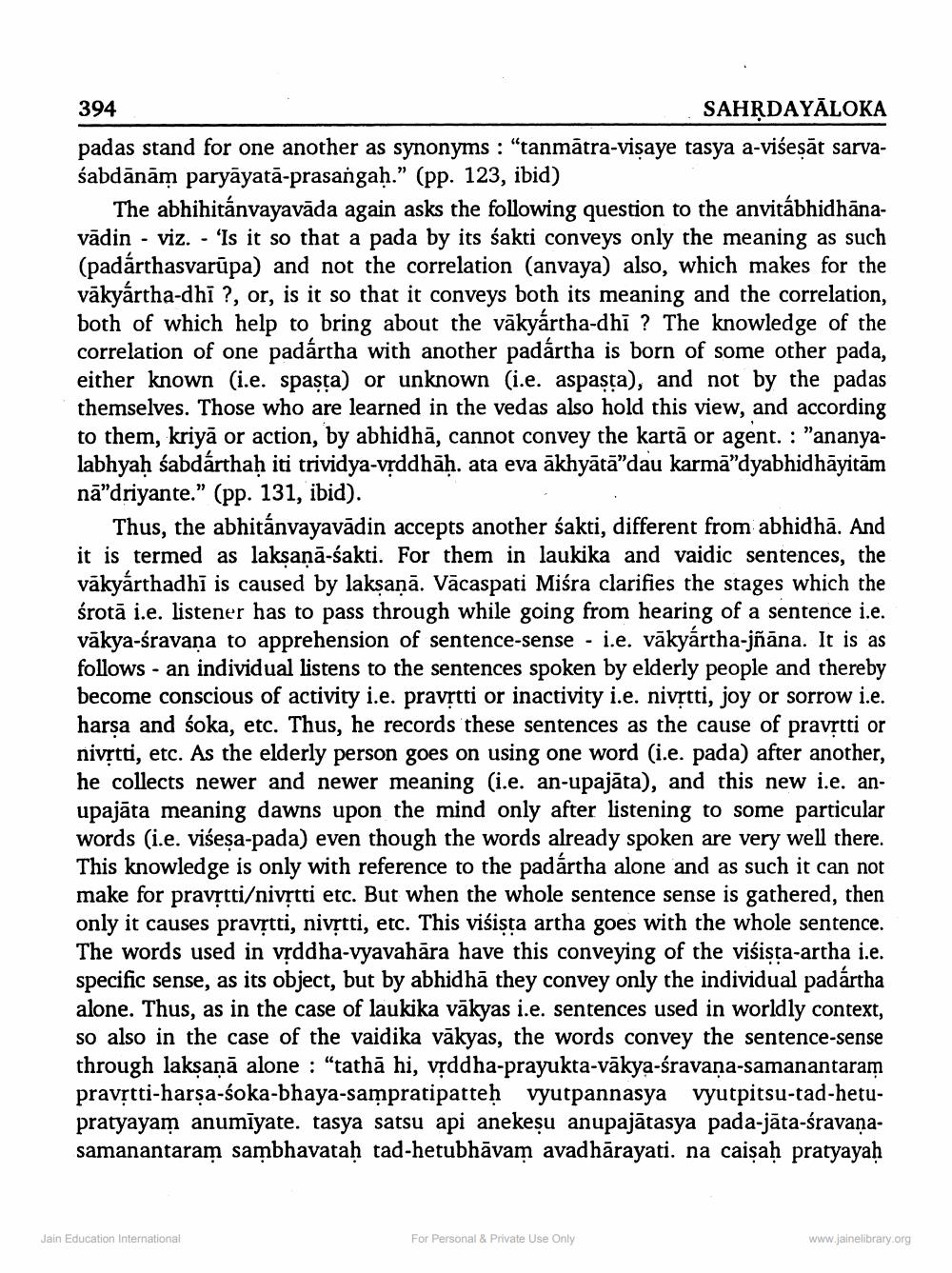________________
394
SAHRDAYĀLOKA padas stand for one another as synonyms : "tanmātra-visaye tasya a-višesāt sarvaśabdānām paryāyatā-prasangah.” (pp. 123, ibid)
The abhihitánvayavāda again asks the following question to the anvitábhidhānavādin - viz. - 'Is it so that a pada by its sakti conveys only the meaning as such (padárthasvarūpa) and not the correlation (anvaya) also, which makes for the vākyártha-dhi ?, or, is it so that it conveys both its meaning and the correlation, both of which help to bring about the vākyártha-dhi ? The knowledge of the correlation of one padártha with another padártha is born of some other pada, either known (i.e. spasta) or unknown (i.e. aspasta), and not by the padas themselves. Those who are learned in the vedas also hold this view, and according to them, kriyā or action, by abhidhā, cannot convey the kartā or agent. : "ananyalabhyah sabdárthah iti trividya-vrddhāh. ata eva ākhyātā”dau karmā"dyabhidhāyitām nā”driyante.” (pp. 131, ibid).
Thus, the abhitánvayavādin accepts another sakti, different from abhidhā. And it is termed as laksanā-sakti. For them in laukika and vaidic sentences, the vākyárthadhi is caused by laksanā. Vācaspati Misra clarifies the stages which the śrotā i.e. listener has to pass through while going from hearing of a sentence i.e. vākya-śravana to apprehension of sentence-sense - i.e. vākyártha-jñāna. It is as follows - an individual listens to the sentences spoken by elderly people and thereby become conscious of activity i.e. pravrtti or inactivity i.e. nivrtti, joy or sorrow i.e. harşa and soka, etc. Thus, he records these sentences as the cause of pravrtti or nivștti, etc. As the elderly person goes on using one word (i.e. pada) after another, he collects newer and newer meaning i.e. an-upajāta), and this new i.e. anupajāta meaning dawns upon the mind only after listening to some particular words (i.e. viśesa-pada) even though the words already spoken are very well there. This knowledge is only with reference to the padártha alone and as such it can not make for pravstti/nivștti etc. But when the whole sentence sense is gathered, then only it causes pravṛtti, nivịtti, etc. This visista artha goes with the whole sentence. The words used in vrddha-vyavahāra have this conveying of the visista-artha i.e. specific sense, as its object, but by abhidhā they convey only the individual padártha alone. Thus, as in the case of laukika vākyas i.e. sentences used in worldly context, so also in the case of the vaidika vākyas, the words convey the sentence-sense through laksanā alone : "tathā hi, vrddha-prayukta-vākya-śravana-samanantaram pravstti-harsa-soka-bhaya-sampratipatteh vyutpannasya vyutpitsu-tad-hetupratyayam anumīyate. tasya satsu api anekeșu anupajātasya pada-jāta-śravanasamanantaram sambhavatah tad-hetubhāvam avadhārayati. na caisah pratyayah
Jain Education International
For Personal & Private Use Only
www.jainelibrary.org




